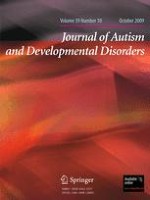01-10-2009 | Original Paper
Dyadic and Triadic Behaviours in Infancy as Precursors to Later Social Responsiveness in Young Children with Autistic Disorder
Gepubliceerd in: Journal of Autism and Developmental Disorders | Uitgave 10/2009
Log in om toegang te krijgenAbstract
The relationship between dyadic (eye contact and affect) and triadic (joint attention) behaviours in infancy, and social responsiveness at pre-school age, was investigated in 36 children with Autistic Disorder. Measures of eye contact and affect, and joint attention, including requesting behaviours, were obtained retrospectively via parental interviews and home videos from 0- to- 24-months of age. Concurrent measures (3–5 years) included social responsiveness to another’s distress and need for help. Early dyadic behaviours observed in home videos, but not as reported by parents, were associated with later social responsiveness. Many triadic behaviours (from both parent-reports and home video) were also associated with social responsiveness at follow-up. The results are consistent with the view that early dyadic and triadic behaviours, particularly sharing attention, are important for the development of later social responsiveness.
